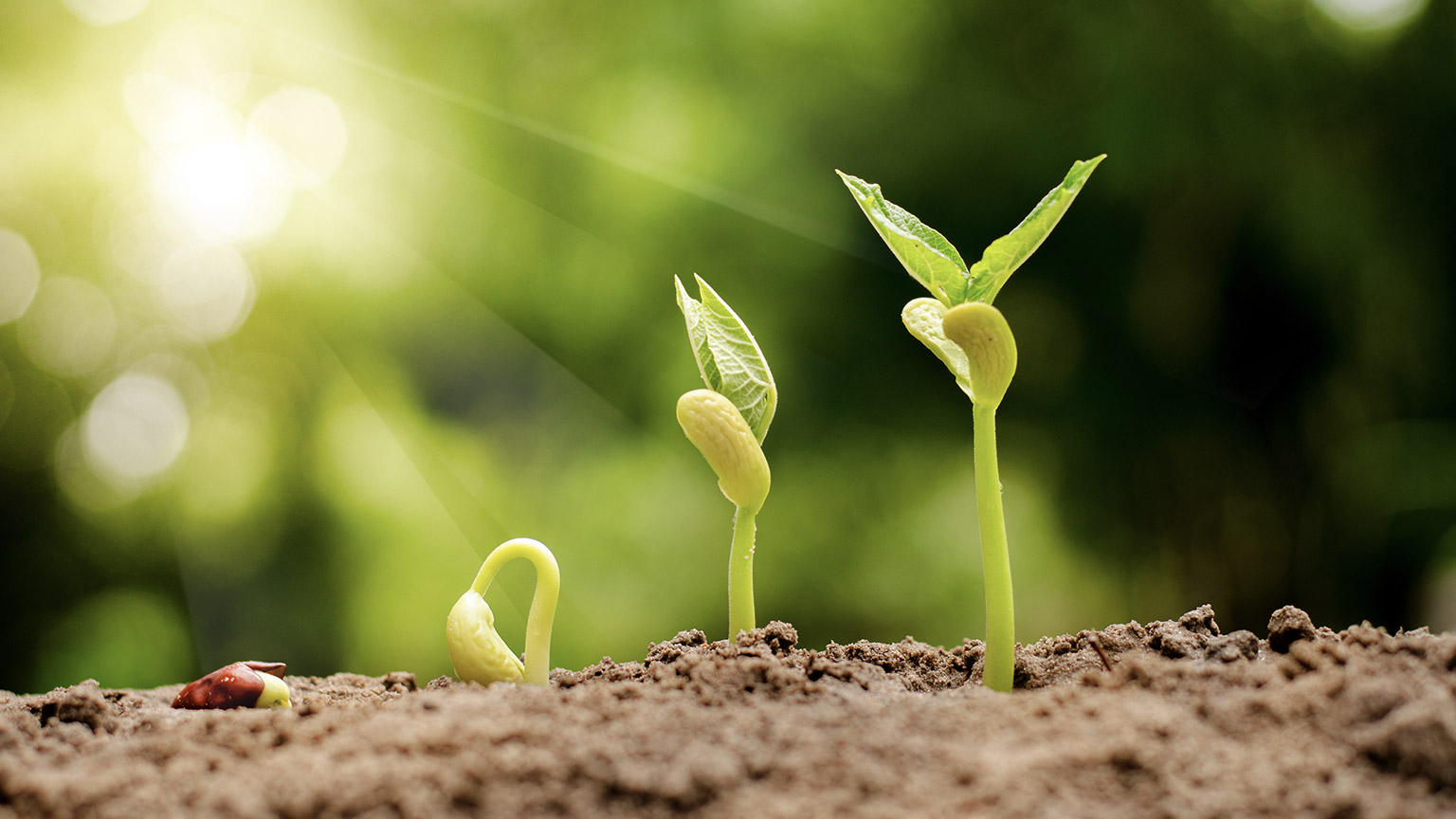In this topic we look at several key processes plants use to grow, develop, and propagate (reproduce). Although this can get a bit “science-y”, we try to keep the explanations about these processes simple. We also explain why knowing about these processes is important for you as a horticulturist or gardener.
- The topic begins by looking at a seed and how this dormant object springs into life through the process of germination.
- Next we look at how plants grow (get bigger) and develop (form new plant parts).
- Then we focus on the water movement in the plant.
- We then look at how plants create, store, and use energy.
- Finally we come full circle by looking at how flowers become fruit and how those fruit bear seeds.
Plant processes overview
When we talk about plant processes, we must remember that plants do everything they do so they can grow old and have kids, so to speak. The plant life cycle shows the main life stages of a plant and how that leads to the propagation of new plants.
Activity – The order of plant processes
Look at the following image closely and complete the activity below.
During each of these stages of life, different plant processes need to take place. The main ones are described in the following sub-topics.
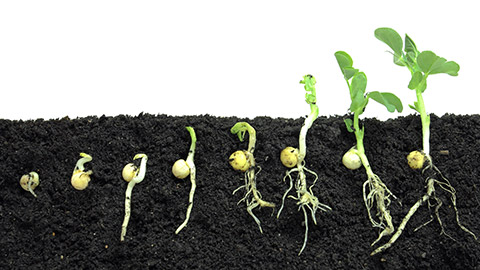
Germination
| Germination | The process of a viable seed undergoing rapid growth and development, forming a root and then a shoot (stem) which lifts the seed leaf or leaves above the soil surface. |
Without certain conditions, seeds are dormant — a state of reduced activity. They are naturally dehydrated (less than 2% is water weight). By comparison, herbaceous plants (non-woody, green and soft-textured) are commonly 95% water by weight. In this dried state, a seed can remain viable for hundreds of years.
When seeds have their needs met — water, air, and warmth — they will start the germination process:
- The seed will convert starch, protein and fat stored in the cotyledons (seed leaves – leaves already formed in the seed) and endosperm (foot storage tissue) into amino acids and sugars.
- These are fed to the embryo, which has the energy to form new cells in the meristems.
- The seed draws in oxygen from the pores of the surrounding soil to extract energy from its energy stores through cellular respiration. We’ll cover cellular respiration in more detail later in this topic.
- With its new burst of energy, the seed pushes its root into the soil to hold itself in place and start absorbing water through an osmosis process. We’ll cover osmosis in more detail later in this topic.
- Next, it pushes its shoot (stem), bent in an upsidedown U shape up through the soil, pulling the seed leaves up with it.
Germination finishes when the shoot emerges from the soil.
Implications for growers
Careful attention to the growing environment when growing from seed helps ensure the germination process is successful.
| Water | Keep the growing medium moist but not too wet. Remember that applying too much water to your soil will push the air out of the pore spaces. Many seed packets indicate to "keep seeds evenly moist." |
| Air | Ensure the growing medium you use is well structured and has pore spaces with air in them. |
| Warmth | Consult the seed supplier’s website for information about the temperature range needed for germination. If the air and soil temperature outside is too low, you can start your seeds in trays, indoors, or even by using a heated pad. |
Seeds don’t need light to germinate, so some commercial growers will start seeds in moist seed trays in heated shipping containers.
Looking ahead
When the seed leaves are above the soil surface, they unfurl and create energy through photosynthesis. This is a significant change. Before this, the seedling relied entirely on its own stored energy.
Now and forever after, the plant will rely on photosynthesis (sunlight, water, and air) to create its energy. We'll look at this in more detail a bit later in the topic.
Primary and secondary growth are the two types of growth occurring in dicot plants throughout their lifecycle.
| Primary growth |
The lengthwise growth of the plant, which occurs in the apical meristems, located at the tips of the roots and shoots. The apical meristem contains undifferentiated cells that continually divide and differentiate into specialized tissues, such as the epidermis, cortex, and vascular tissues. |
| Secondary growth |
The increase in thickness or circumference of the plant, which occurs in the lateral meristems located in the cambium layer of the stems and roots. Typically occurs in woody plants, allowing them to become taller and more structurally stable over time. Secondary growth is responsible for the formation of tree rings. During secondary growth, the vascular cambium of the tree produces secondary xylem, which accumulates year after year, forming concentric rings that can be seen when a tree is cut down. |
[In secondary growth:] The cambium is the meristem responsible for the formation of wood [xylem] and bast [phloem], the two types of vascular tissues important for long-distance transport of water and assimilates [the products of photosynthesis, such as glucose, fructose, and sucrose], respectively.Ragni and Greb 2018
How we see primary and secondary growth
Primary growth examples:
The rapid lengthening growth of seedlings after they emerge from the soil and the penetration of roots deep into the soil.
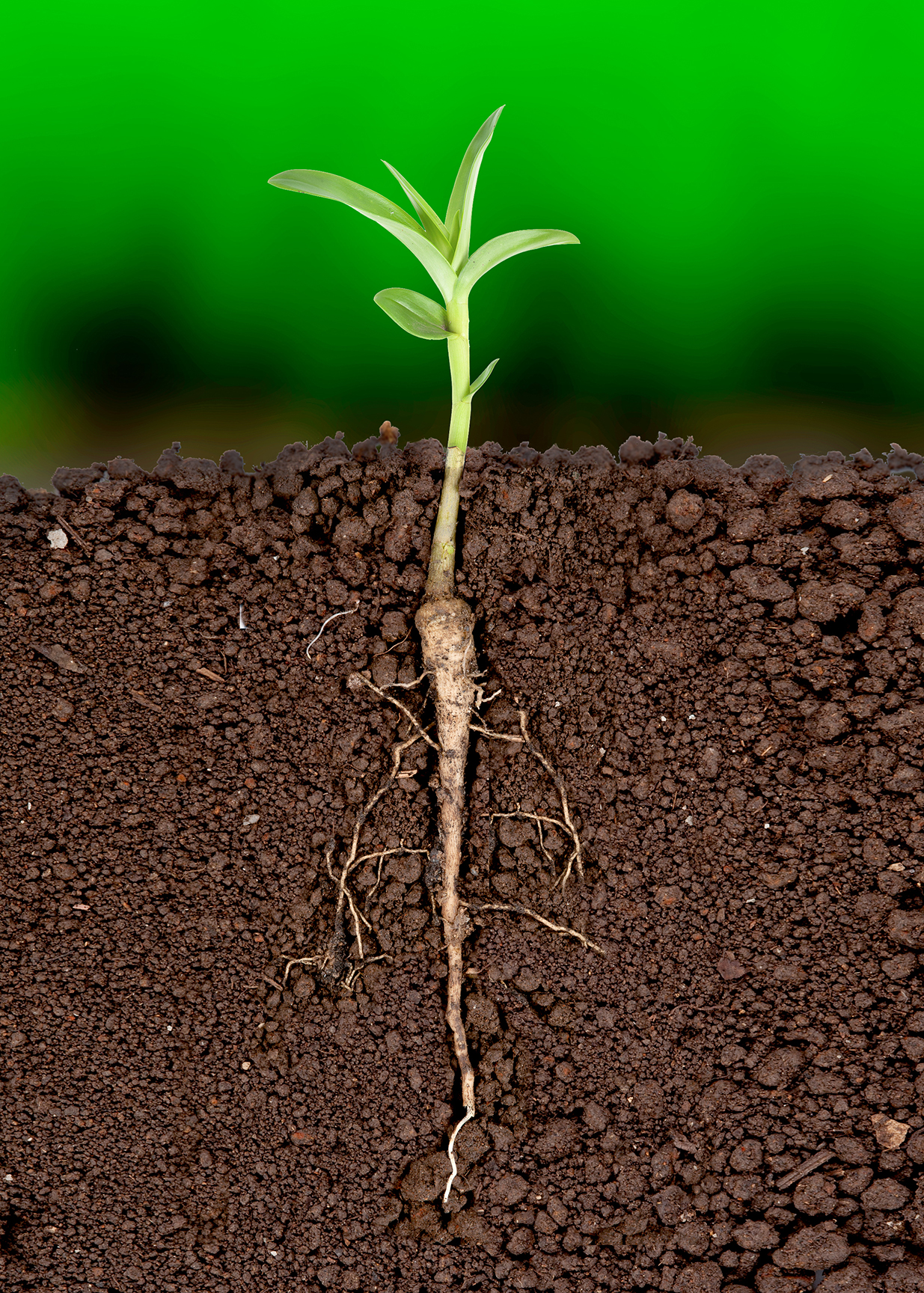
Secondary growth example:
The thickening of a tree trunk, which turns a tender new seedling's stem into a woody tree truck in its maturity.
Obstructions such as this metal post and stubs of limbs can be engulfed.
Source: Wikipedia and Wikimedia commons (image)
Monocots don't get woody trunks
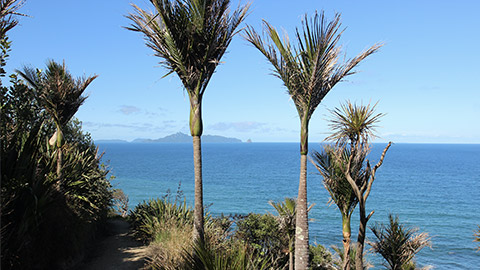
Generally, monocot plants don’t undergo secondary growth. Palms (Arecaceae or Palmae) may appear to be an exception, but they are not.
Because vascular and cork cambia are absent, there is no secondary growth leading to the development of wood and bark. Trunk thickening in large monocots, such as palms, simply results from the repeated formation of the scattered vascular bundle pattern.
“Botany for Gardeners: Revised Edition.” Capon, B. 2005.
Activity – Plant processes: primary and secondary growth
Take this short quiz to test your understanding.
Implications for growers
Pruning can stimulate secondary growth by removing apical dominance. Removing the terminal bud encourages lateral buds to grow, leading to increased branching and thicker stems.
Tip: The word apical comes from the word apex. Apex means the tip of an item, such as a mountain or your tongue.
Osmosis in plants allows the movement of water. For our purposes, we'll use the following definition.
| Osmosis | The process where water molecules move from the soil (an area of high concentration) to the middle of the plant's root (an area of low concentration) through a selectively permeable layer (allows water through sometimes.) |
Water enters the plant through the outer cells (the epidermal cells) of the root and passes through into the spaces between the internal (cortex) cells.
Osmosis plays a vital role in the uptake and distribution of water and dissolved nutrients.
Watch
Watch the following video to learn how plant roots absorb water and minerals.
Implications for growers
Ensuring enough water in the growing medium is essential for plant growth. Remember, though, we don’t want the soil to be too wet, or there won’t be enough air in the pore spaces needed for other plant processes.
Watch
Watch this video and avoid common watering mistakes. If it doesn't automatically, you may like to start at 0:33.
Once the water has entered the plant through osmosis, it needs to make its way to other parts of the plant. This happens through two main processes called root pressure and transpirational pull.
Before we explain these two processes, we need to describe the parts of the plant responsible for moving water and energy — the vascular bundle.
Vascular bundle
The vascular bundle is a group of tissues responsible for transporting water, minerals, and other nutrients throughout the plant body. It is made up of two types of specialised tissues: the xylem and phloem, along with other tissues that provide support and protection.
| Xylem | Responsible for transporting water and minerals from the roots to the leaves. The Biology Dictionary explains how the xylem is like a straw: "The xylem is created from hollow, dead cells… In this way, the xylem serves as a straw, allowing water to carry minerals upwards through the plant”. |
| Phloem | Responsible for transporting sugars and other nutrients from the leaves to other parts of the plant. The Biology Dictionary explains that this tissue's purpose is managing sugars. “Unlike the xylem, this vascular tissue is made up of living cells… [and] unlike water, sugar is thick and sappy. The phloem requires water inputs from the xylem and specialized proteins to help quickly pass the sugars through the plant.” |
Both xylem and phloem are arranged in a particular pattern within the plant. (As shown on the images below.) In dicot stems, the vascular bundle is usually arranged in a ring formation close to the edge of the plant, while in monocot stems, vascular bundles are scattered throughout the stem. In a stem or root, the xylem is typically closer to the centre of the stem or root while the phloem is closer to the exterior.
In woody dicots, the vascular tissue is even more organized, with a vascular cambium layer producing xylem inside and phloem outside. These layers are produced seasonally, which give woody plants their characteristic “rings”. By adding to the vascular tissue every season, these plants can handle an increase in growth and become very large.
Labelled parts of a vascular bundle of a dicot plant.
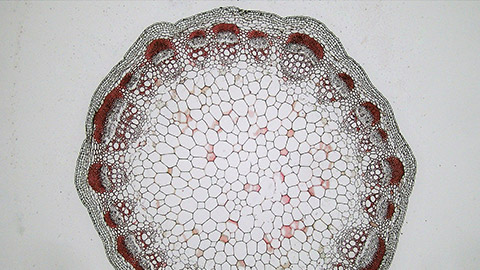
The distribution of vascular bundles in a dicot plant.
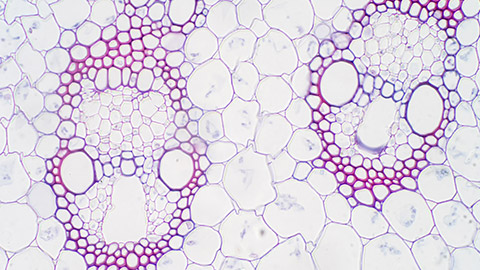
The distribution of vascular bundles in a monocot plant.
Root pressure
| Root pressure | This is where water is pushed up from the roots to the stem and leaves. As water flows into the roots through osmosis, the xylems in the roots fill up, pushing water up through the stems. |
Root pressure is most significant in young plants when the transpiration rate is low, and the water demand is not high. Root pressure only provides enough force to get water to the lower parts (stems and leaves) of larger plants.
Root pressure can be observed in some plants, such as grasses, during the early morning when transpiration is low and dew has accumulated on the leaves. In this case, the root pressure can push water up to the leaves, causing droplets of water to be expelled through the leaf tips, a process known as guttation.
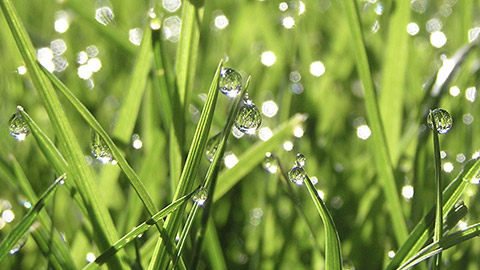
Guttation drops are visible on these grass leaves.
But the main action for moving water around plants is through transpirational pull.
Transpiration
| Transpiration | A process where water vapour is lost through the stomata of plants. This loss cools the plant, which gently pulls water from the stem and roots upwards into the leaves. |
| Transpirational pull | The negative pressure (or tension) that occurs in the water column within the xylem when water evaporates from the leaves. This tension draws water up the xylems of the plant. Note that tension is not the same as suction, but that's beyond the scope of this course. |
If you’re especially interested in the science behind how trees can pull water, in some cases over 100m above the ground, watch this video by Derek Muller. If you like it, you can follow his channel, Veritasium. You can also read this explainer by Lê Nguyên Hoang. He describes it as being the "most mind-blowing scientific video [he has] ever seen."
Watch
If that doesn’t interest you, all you need to know is that water is transported to the higher parts of the tree through negative pressure created by water evaporating from stomata in the plant’s leaves.
Implications for growers
During times when it is hot, plants transpire more, which draws more water into the plant through the roots. If the soil is dry, the amount of water in plant cells will start to decrease, and critical plant processes will be disrupted. By knowing how much water a plant is losing through transpiration, we can ensure we provide enough water to our plants. That's called evapotranspiration losses, and we'll cover that in-depth later in the course.
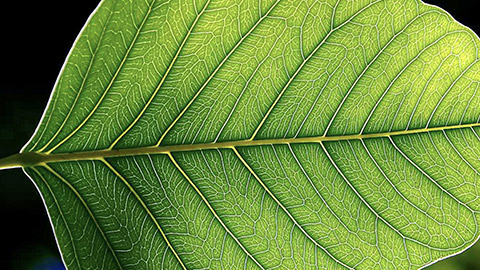
| Photosynthesis |
The process by which green plants and other organisms with chlorophyll convert light energy from the sun into chemical energy in the form of glucose (sugar). It enables plants to produce their own food! |
During photosynthesis, the plant absorbs light energy from the sun using chlorophyll, a green pigment found in leaves and other parts of the plant. Plant leaves and other parts are green because the chlorophyll absorbs other colours of light but for the most part reflects the green light.
This energy is then used to combine carbon dioxide from the air with water from the soil, to produce glucose (sugar) and oxygen. The glucose is used by the plant as a source of energy for growth and development, while the oxygen is released into the air as a byproduct through small holes on the bottom of the leaves called stomata.
As we mentioned in earlier courses, the quality of light is important, not just the quantity (how much light) the plant receives. The parts of the electromagnetic spectrum most important to plant growth are those between 400 and 700 nanometres. We see this as visible light and is sometimes called photosynthetically active radiation (PAR). Ultraviolet and infrared energy (light) offer little benefit to plants when it comes to photosynthesis.
This image shows the relative quantum efficiency curve of photosynthesis. The taller the section of the graph, the more effectively plants can use this light for photosynthesis.
The following video provides a deeper dive into photosynthesis.
Implications for growers
Indoor growing operations often require artificial lights in addition to (or instead of) sunlight. Specialist growth lights must be used to achieve yields comparable to plants grown in sunlight. These growth lights must provide high amounts of red and blue light. Some research shows that including green light could be beneficial for photosynthesis too. Still, more importantly, it makes it easier for the eyes of people working in these areas.
| Translocation | This is the process by which organic compounds, such as sugars, amino acids, and hormones, are transported from sources to sinks in plants through the phloem. As described previously, the phloem is specialised vascular tissue formed for this purpose. |
| Sink tissues | Areas of high metabolic activity, including the roots, developing fruits, flowers, and new leaves. Sink tissues require continuous nutrients and energy to support their growth and metabolic processes. |
The glucose formed by photosynthesis is not very soluble and cannot be transported efficiently through the phloem. To overcome this problem, plants convert glucose into sucrose (a more soluble sugar), which can be transported efficiently through the phloem. Once sucrose is synthesized in the leaves, it is loaded into the phloem and transported to sink tissues elsewhere in the plant.
The pressure difference between the source and the sink, where the organic molecules are needed, causes the organic molecules to flow through the phloem. The flow of organic molecules is regulated by companion cells. When the sugar has been deposited in the sink cells, the water that remains (which was part of the sugar solution) makes its way into the xylem and is used in transpiration.
The translocation of sucrose (sugar) from a source cell to a sink cell through the phloem is due to positive pressure. When the sucrose is unloaded from the solution, the remaining water moves into the xylem and is used for transpiration.
Source: Georgia Tech Biological Sciences. Organismal Biology
Activity - Watch and learn
This video explains the process we've been describing in this topic. Watch it and then complete the questions that follow.
Now you can confirm your understanding with this quiz.
Implications for growers
Transpiration occurs more rapidly when the weather is hot, dry, and windy. You can slow down transpiration and therefore reduce the amount of water needed by the plant by making changes to the growing environment. For instance, you could put up fences or hedges around your garden to reduce the windspeed or put shade-cloth over your plants to reduce the amount of sunlight (heat) getting to them.
Sugars used for plant growth are translocated through the phloem close to the bark. In some cases, growers prefer that the sugars stay higher in the plant to enhance fruit yields. For example, kiwifruit growers may remove a strip of bark from the circumference of the stem or branch, which damages the phloem tissue. This disrupts the flow of carbohydrates and other nutrients, causing them to remain in the upper portion of the plant. This process is known as girdling.
It's important to note that girdling can have negative effects on the plant if it is done:
- on the wrong type of plant
- incorrectly
- at the wrong time of year.
| Cellular respiration | The process by which plants convert stored energy into usable forms of energy. The stored energy is the glucose formed through photosynthesis. Where it has been translocated as sucrose, it is often converted back to glucose and fructose before it can be used by the sink tissue for energy. |
Respiration in plants is similar to respiration in animals in that it involves the breakdown of carbohydrates, such as sugars and starches, to produce energy. However, the process of plant respiration involves different cell structures and mechanisms. It occurs in all of the plant’s living cells, including sink tissue.
During cellular respiration, oxygen is used to break down glucose into energy that the cell can use, and this process releases carbon dioxide as a waste product.
Plants need oxygen for respiration, but they don’t have a circulatory system that distributes oxygen over long distances like animals do. How far plants can transport oxygen depends on the species. For example, some flood-tolerant species are able to transport oxygen further than those that aren’t flood-tolerant.
Instead, for the most part, plants absorb oxygen where it’s needed, which means they need to take in air through their roots as well as through their leaves, and stems.
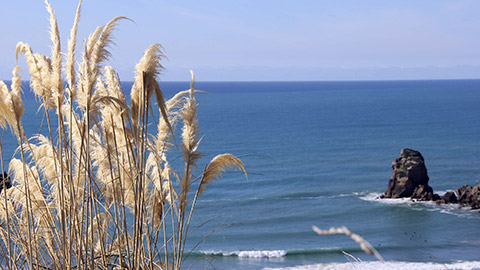
According to thisNZlife, Toetoe (Austroderia spp.) is an example of a (flood-tolerant) native New Zealand plant that can survive underwater for a couple of days.
Note that respiration does not require light (unlike photosynthesis) so it can occur during the day or at night.
It can also occur in deciduous trees when they are without their leaves, in regions with mild winters and adequate soil moisture. In these situations, the plant is not dormant, but its level of activity is reduced. Because respiration occurs in all cells, some deciduous trees may continue to grow their roots throughout the winter months, albeit at a slower rate than during the growing season.
Implications for growers
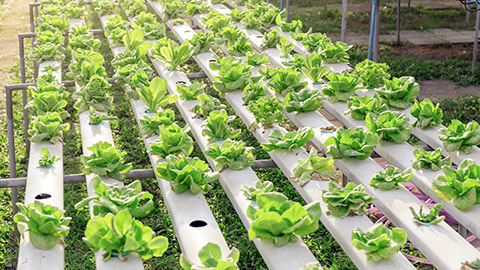
Hydroponics systems allow a grower to use water instead of soil or compost as the growing medium. These systems provide air to the roots in a few different ways to ensure the roots get enough oxygen. Oxygen is necessary for respiration in the root cells, which creates the energy needed for root growth.
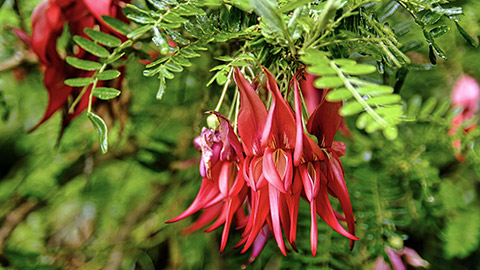
Kakabeak (Clianthus puniceus) is a striking red flower that resembles a parrot's beak and is endemic to New Zealand.
Flowers are the reproductive structures of angiosperms or flowering plants. The process of flower formation, also known as floral development, involves a complex series of events that leads to the production of mature flowers capable of producing seeds.
The key steps in the process of flower formation are shown in the following activity. Carefully read each definition below and try putting them in the correct order.
Activity – The order that flowers develop
Implications for growers
All this development and growth requires energy, so the plant must have access to ample amounts of light, water and carbon dioxide for photosynthesis and oxygen to combine with stored sugars for respiration.
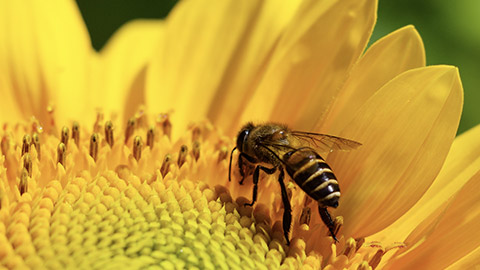
Bees feed on the nectar of sunflower flowers. Sunflowers (Helianthus annuus) produce large and showy flowers with a central disk that contains many small flowers, known as florets. Each floret produces nectar, which is a sweet liquid that attracts pollinators like bees, butterflies, and hummingbirds.
Once the flower is mature, it is ready for pollination, which involves the transfer of pollen from the anthers of the stamen to the stigma of the carpel. If the pollination is successful, fertilisation occurs, and the ovules inside the flower's ovary develop into seeds.
The ovule is the structure inside the flower's ovary, containing the female gamete or egg cell. The ovule is usually composed of several layers, including the integuments, which are protective layers surrounding the embryo sac, the ovule's part containing the egg cell.
When a pollen grain lands on the stigma of a flower, it begins to grow down the style and into the ovary, where it reaches the ovules. This new structure that grows down the style is called a pollen tube. Chemical signals produced by the female reproductive structures guide the pollen tube toward the micropyle. This small ovule pore allows the pollen tube to enter.
The male gamete inside the pollen tube then fertilises the female gamete inside the embryo sac, forming a zygote, which develops into an embryo. The ovule then develops into a seed containing the embryo and a supply of nutrients for the developing plant.
Implications for growers
Like with floral development, seed and fruit formation requires energy, so we must ensure our plants have access to enough light, water, carbon dioxide and oxygen.
Additionally, sunlight helps many types of fruit ripen by producing the pigments that give these fruits their characteristic colour and flavour. Pruning to allow light to fall on ripening fruit will help speed up this process.
Additional resource
If you’re interested in knowing more about these, and other plant processes, Botany for Gardeners by Brian Capon is a fantastic book.
